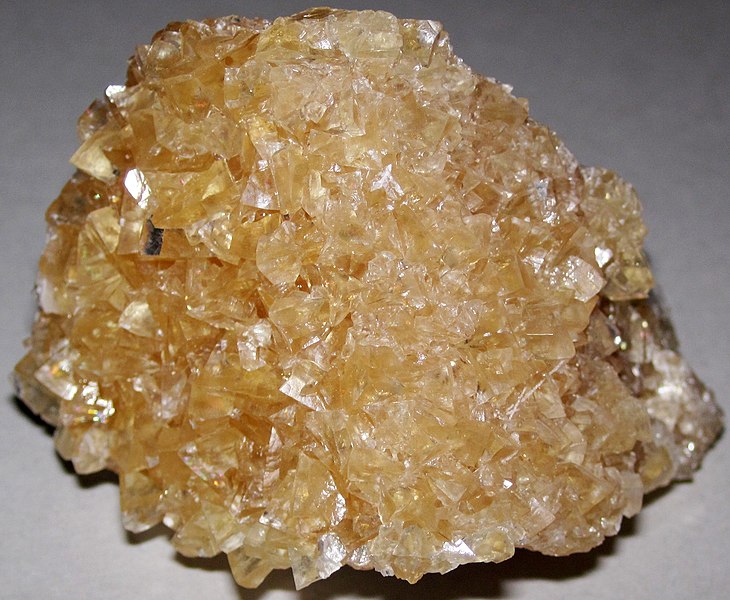File:Calcite (Stillwater Mine, Beartooth Mountains, Montana, USA) 1.jpg

Original file (2,351 × 1,931 pixels, file size: 2.99 MB, MIME type: image/jpeg)
Captions
Captions
Summary[edit]
| DescriptionCalcite (Stillwater Mine, Beartooth Mountains, Montana, USA) 1.jpg |
English: A mineral is a naturally-occurring, solid, inorganic, crystalline substance having a fairly definite chemical composition and having fairly definite physical properties. At its simplest, a mineral is a naturally-occurring solid chemical. Currently, there are over 5600 named and described minerals - about 200 of them are common and about 20 of them are very common. Mineral classification is based on anion chemistry. Major categories of minerals are: elements, sulfides, oxides, halides, carbonates, sulfates, phosphates, and silicates.
The carbonate minerals all contain one or more carbonate (CO3-2) anions. Calcite is a common mineral. It is calcium carbonate (CaCO3). It has a nonmetallic luster, commonly clearish to whitish to yellowish to grayish in color, is moderately soft (H≡3), moderately light-weight, has hexagonal crystals, and rhombohedral cleavage (three cleavage planes at 75º & 105º angles - cleavage pieces look like lopsided boxes). The easiest way to identify calcite is to drop acid on it - it easily bubbles (effervesces) in acid. The bubbles are carbon dioxide gas. If the acid is dilute hydrochloric acid, the chemical reaction is: 2HCl(aq) + CaCO3(s) -->> CO2(g)↑ + H2O(l) + CaCl2(aq) The most important & voluminous calcitic rocks in the world are limestone (sedimentary), marble (metamorphic), carbonatite (igneous), and travertine (speleothem, or "cave formations", and many hotspring deposits). Many hydrothermal veins in the world are calcitic or have calcite as a principal component. The honey yellow calcite crystals seen here are from an underground mine in Montana - the famous Stillwater Mine, which produces platinum and palladium. The platinum ores are very old, Precambrian rocks. The calcite is late-stage, fracture-lining mineralization unrelated to the formation of those rocks. Geologic context: crystal-lined, open fracture in rocks of the Johns-Manville Reef, Troctolite-Anorthosite I zone, Lower Banded Series, Stillwater Complex, upper Neoarchean, 2.7 Ga Locality: Stillwater Mine, southwest of the town of Nye, southwestern Stillwater County, Beartooth Mountains, southern Montana, USA Photo gallery of calcite: www.mindat.org/gallery.php?min=859 |
| Date | |
| Source | https://www.flickr.com/photos/47445767@N05/50820337987/ |
| Author | James St. John |
Licensing[edit]
- You are free:
- to share – to copy, distribute and transmit the work
- to remix – to adapt the work
- Under the following conditions:
- attribution – You must give appropriate credit, provide a link to the license, and indicate if changes were made. You may do so in any reasonable manner, but not in any way that suggests the licensor endorses you or your use.
| This image was originally posted to Flickr by James St. John at https://flickr.com/photos/47445767@N05/50820337987. It was reviewed on 11 January 2021 by FlickreviewR 2 and was confirmed to be licensed under the terms of the cc-by-2.0. |
11 January 2021
File history
Click on a date/time to view the file as it appeared at that time.
| Date/Time | Thumbnail | Dimensions | User | Comment | |
|---|---|---|---|---|---|
| current | 14:40, 11 January 2021 |  | 2,351 × 1,931 (2.99 MB) | Ser Amantio di Nicolao (talk | contribs) | Uploaded a work by James St. John from https://www.flickr.com/photos/47445767@N05/50820337987/ with UploadWizard |
You cannot overwrite this file.
File usage on Commons
There are no pages that use this file.
Metadata
This file contains additional information such as Exif metadata which may have been added by the digital camera, scanner, or software program used to create or digitize it. If the file has been modified from its original state, some details such as the timestamp may not fully reflect those of the original file. The timestamp is only as accurate as the clock in the camera, and it may be completely wrong.
| Camera manufacturer | Canon |
|---|---|
| Camera model | Canon PowerShot D10 |
| Exposure time | 1/60 sec (0.016666666666667) |
| F-number | f/10 |
| ISO speed rating | 80 |
| Date and time of data generation | 01:11, 10 January 2021 |
| Lens focal length | 9.681 mm |
| Width | 4,000 px |
| Height | 3,000 px |
| Bits per component |
|
| Pixel composition | RGB |
| Orientation | Normal |
| Number of components | 3 |
| Horizontal resolution | 180 dpi |
| Vertical resolution | 180 dpi |
| Software used | Adobe Photoshop Elements 18.0 (Macintosh) |
| File change date and time | 03:28, 10 January 2021 |
| Y and C positioning | Co-sited |
| Exif version | 2.21 |
| Date and time of digitizing | 01:11, 10 January 2021 |
| Meaning of each component |
|
| Image compression mode | 3 |
| APEX shutter speed | 5.90625 |
| APEX aperture | 6.65625 |
| APEX exposure bias | −0.66666666666667 |
| Maximum land aperture | 3.625 APEX (f/3.51) |
| Metering mode | Pattern |
| Flash | Flash fired, compulsory flash firing, red-eye reduction mode |
| Supported Flashpix version | 1 |
| Color space | sRGB |
| Focal plane X resolution | 16,460.905349794 |
| Focal plane Y resolution | 16,483.516483516 |
| Focal plane resolution unit | inches |
| Sensing method | One-chip color area sensor |
| File source | Digital still camera |
| Custom image processing | Normal process |
| Exposure mode | Manual exposure |
| White balance | Auto white balance |
| Digital zoom ratio | 1 |
| Scene capture type | Standard |
| Lens used | 6.2-18.6 mm |
| Date metadata was last modified | 22:28, 9 January 2021 |
| Unique ID of original document | DD96996D79EDAF9964F5A7AB6B16EBE9 |
| IIM version | 24,576 |